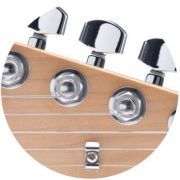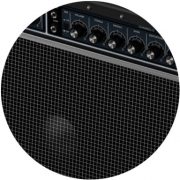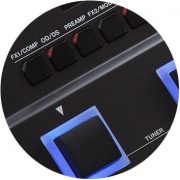The Beatles. What can be said that hasn’t already been written about (and over analysed) so many times before!? While we’re all familiar with the legacy of songs they’ve given us, they’re also directly (and indirectly) responsible for many new recording techniques that were developed during their recording career.
One of these techniques was used to achieve the unique guitar tone on the rock hit Revolution from the epic White Album, released in 1968. This fuzzed up guitar tone is somewhat difficult to replicate, in that they didn’t use a guitar amp to generate it. According to Geoff Emerick (the studio engineer for that session), he had John Lennon and George Harrison running their guitars directly into the mixing desk. The guitar tone is a result of one channel on the mixing desk being run into another. Both of these channels were driven well beyond their normal operating capacity. Bad news for the desk (it could have overheated and caused permanent damage), good news for guitar tone history!
To recreate this tone, I’m going to use the BOSS GT-1 entry-level, multi-effects unit. While it’s great if you have access to a real vintage REDD mixing desk to overdrive the actual channel preamps used for this recording, (hmm…probably unlikely), it’s still not exactly a practical solution for a guitarist!
To chase this tone, we need to be thinking outside-the-box of normal guitar tone shaping. Trying to replicate the “drive” of a channel on a mixing desk to get a “usable” guitar tone is a different process than working with a guitar amp. If you’ve ever tried running a BOSS DS-1 Distortion pedal directly into a mixing desk (and heard the awful, fizzy result), then you will have some insight into just how different a process this is!
We’ll be looking for a clean amp to simulate the desk, some fuzz to get the overdrive tonal characteristics right, and some compression to simulate both the tape saturation and desk drive.
Firstly, let’s break down the components of tone in a process I call, the 4 Elements of Tone.
Visit guitarfxpatches.com and download free guitar tone from Revolution using Discount Code: GT1REVOLUTION
Contributed by Josh Munday – Tone Designer for the Roland Australia Blog
1. The Guitar
 In this case it’s “Guitars”. Both John Lennon and George Harrison were playing for this session. We’ll refer again to Geoff Emerick’s recollection of the session. The guitars were apparently an Epiphone Casino and Gibson SG. Regardless of the detail, we are looking to replicate a humbucker-equipped guitar. I used a Mexican Fender Strat in the video for this tone design segment, which obviously doesn’t have a humbucker, but we’ll be able to adjust the EQ and compression to allow for this. I like to use very “plain” and familiar sounding guitars for tone design, because it’s easier for others to replicate and shows that this is possible, even with basic/affordable gear (i.e. Mexican Strat + GT-1).
In this case it’s “Guitars”. Both John Lennon and George Harrison were playing for this session. We’ll refer again to Geoff Emerick’s recollection of the session. The guitars were apparently an Epiphone Casino and Gibson SG. Regardless of the detail, we are looking to replicate a humbucker-equipped guitar. I used a Mexican Fender Strat in the video for this tone design segment, which obviously doesn’t have a humbucker, but we’ll be able to adjust the EQ and compression to allow for this. I like to use very “plain” and familiar sounding guitars for tone design, because it’s easier for others to replicate and shows that this is possible, even with basic/affordable gear (i.e. Mexican Strat + GT-1).
2. The Pickup Selection
 The pickup selection is definitely a bridge pickup tone. A fuzz type drive can often darken the tone and soften the attack, so we need all the brightness we can get from the guitar.
The pickup selection is definitely a bridge pickup tone. A fuzz type drive can often darken the tone and soften the attack, so we need all the brightness we can get from the guitar.
3. The Amp
 As I mentioned earlier, there was no amp! Two channels on the EMI REDD mixing desk were used. The input gain of the channel was driven…hard! The two channels were run in series, (i.e. one fed into the other), to get even more overdrive from the desk.
As I mentioned earlier, there was no amp! Two channels on the EMI REDD mixing desk were used. The input gain of the channel was driven…hard! The two channels were run in series, (i.e. one fed into the other), to get even more overdrive from the desk.
When selecting an amp, there are some basic rules of thumb that will help:
ALWAYS START WITH EVERYTHING OFF!!!
I can’t stress this enough. Find the OFF button for everything in the signal chain, so all you can hear is your dry old guitar sound coming through. Remember, any multi-FX/amp simulator like the BOSS GT-1 is just simulating a room full of gear, so think about it like that. You wouldn’t walk into a room full of amps and FX and start by turning everything ON would you? You would plug into an amp, get a good basic tone, then turn on any effects, one at a time and build up your sound…likewise with any multi-FX.
- Set the EQ “flat” (i.e. all settings at the halfway point, or at 12 o’clock). This gives you a neutral starting point so that the EQ isn’t colouring the tone too much yet.
- Put the gain up to about a quarter to half a turn, so you can hear the gain character.
So what amp do we use to try to simulate a mixing desk? We need to use an amplifier simulator that will give us a full range of frequencies to work with. Guitar amplifiers usually have a very limited frequency bandwidth focus, so that won’t do. Fortunately, the BOSS GT-1 has an amplifier simulator called ‘FULL RANGE’ (often used for acoustic guitars), that will give us a full frequency representation that is somewhat similar to a mixing desk.
The amp settings are written below. But, the process of getting there is of course, trial and error (isn’t ALL guitar tone!?). I’ve driven the GAIN of the amp (as they did in the studio), but that didn’t get the same result (since it’s not the same gain stage as the original desk). The fuzz and compression we are going to add next will start to give us the right characteristics and will also react to the amp simulator settings.
The settings I’ve chosen are:
- GAIN – 84
- BASS – 57
- MIDDLE – 69. Just boosting the MIDDLE on the amp setting still wasn’t quite right for this tone. So, I also used the EQ in the MASTER SETTING section of the signal chain to boost the MID GAIN setting. I used a setting of +10dB, and you can select the frequency of the midrange in this part, so I turned this to 630Hz to try and simulate the specific midrange frequency from the recording.
- TREBLE – 40
- PRESENCE – 69
As well as the EQ setting for the amp, I’ve also used the EQ in the MASTER SETTINGS part of the signal chain to tweak the tone. Boosting or cutting the EQ on the Amplifier Simulator has a different effect on the tone than the MASTER SETTING section. Think of the AMP EQ as changing the EQ on the Virtual Amplifier and the MASTER SETTINGS EQ as changing the EQ on the mixing board, after it has been recorded.
The setting I’ve selected in the MASTER SETTINGS section are:
- PATCH LEVEL – 94
- LOW GAIN – 0
- MID GAIN – 7
- MID FREQ – You can also select the frequency of the midrange in this part, so I turned this to 630Hz to try to simulate the specific midrange frequency of the recording.
- Q MID – 1. This determines how much the frequencies surrounding the midrange frequency you’ve set will be affected. The lower the number, the more frequencies surrounding the MID FREQ setting will be affected when you boost or cut in the MID GAIN setting.
- HIGH GAIN – 0
Now to the other effects.
4. The Effects
 Before we get start, I just want to explain what I mean by “effects”. This means not only traditional effects that you would run in the main input, or in the effects loop of your amplifier, (such as overdrive pedals, chorus, etc), but also any effects that were added later in the mixing process, or “Post-Production” effects. Delays for instance, are often added after the track has been recorded. Other elements that I would count in the Effects section are:
Before we get start, I just want to explain what I mean by “effects”. This means not only traditional effects that you would run in the main input, or in the effects loop of your amplifier, (such as overdrive pedals, chorus, etc), but also any effects that were added later in the mixing process, or “Post-Production” effects. Delays for instance, are often added after the track has been recorded. Other elements that I would count in the Effects section are:
- EQ and compression, adjusted in the mixing stage.
- The microphone that is on the speaker cabinet. What did it sound like?
- Was there a second microphone in the room, away from the speaker cabinet?
- How far away from the speaker cabinet was the mic?
- How loud is that second mic in the mix?
- What did the room sound like from that room mic?
- etc…etc…etc….and on and on it goes.
Many of these details are not applicable because of the way this tone was recorded, except for EQ and compression.
https://www.youtube.com/watch?v=uNdoc2DSgAM
Gain Pedal
Since the drive of the FULL RANGE amplifier doesn’t sound like the drive for this tone, I used the ’60S FUZZ setting from the OD section in the signal chain. I already have the drive on the FULL RANGE amplifier fairly high. So, we shouldn’t have to run the drive on this pedal very high to get that fuzzed-out tone. As I mentioned earlier, fuzz drives often roll-off the treble frequencies, so I’ve boosted them in order to get more “fizz” in the treble area.
Settings used:
- TYPE – ’60S FUZZ
- DRIVE – 43
- E.LEVEL – 61
- TONE – +50
- BOTTOM – +1
- D.LEVEL 0
Compression
At this point we’re almost there, but we’re still missing some attack to the tone (it’s still a little soft from the FUZZ pedal, even though we boosted the treble). Adding a compressor to our effects chain will give us that immediacy of attack that’s in the recording. It also brings up other frequencies, so the overall effect is that the tone appears to be sitting right at the front of the speakers with a lot of presence. You can often hear that when you listen to the vocals in many Beatles songs, where you would swear you were in the room with them, (e.g. Lucy in the Sky with Diamonds…).
We’re going to add the compressor in the FX1/COMP section of the signal chain.
Settings used:
- TYPE (of effect) – COMPRESSOR
- TYPE – BOSS
- SUSTAIN – 72
- LEVEL – 35
- ATTACK – +100
- TONE – 0
Control Pedal Assign
No controls needed for this tone. So, you can set the Control Pedal to Off. Or, use a solo boost if you want to raise the level between the intro lick and the rhythm part.
And that’s it!
There you have it guys, the guitar tone from Revolution. If you have a BOSS GT-1 and don’t want to have to program this tone yourself, you can download it from my website.
Just enter this Discount Code and you can get it for FREE!
Website = guitarfxpatches.com
Discount Code = GT1REVOLUTION
Related Articles
JIMI HENDRIX ‘VOODOO CHILD (SLIGHT RETURN)’ TONE DISSECTED
THE POLICE ‘WALKING ON THE MOON’ TONE DISSECTED
STEVIE RAY VAUGHAN ‘PRIDE AND JOY’ TONE DISSECTED
VAN HALEN ‘ERUPTION’ TONE DISSECTED
FOUR ELEMENTS OF GUITAR TONE
TONES IN TIME – 60S ROCK
JIMI HENDRIX’S ‘FOXY LADY’ TONE DISSECTED

